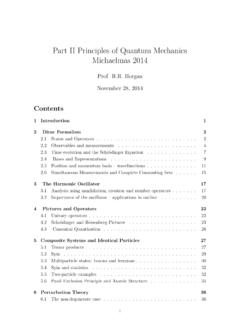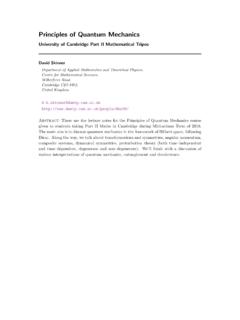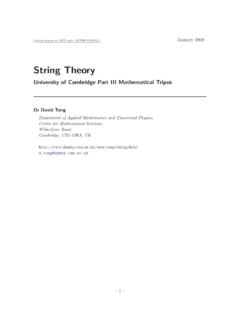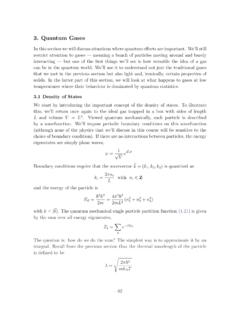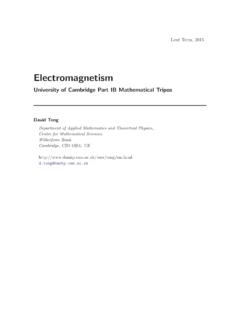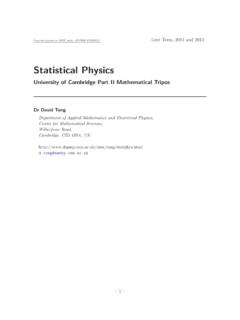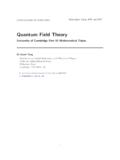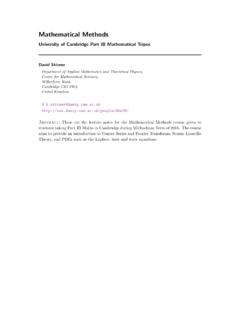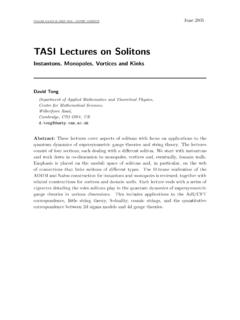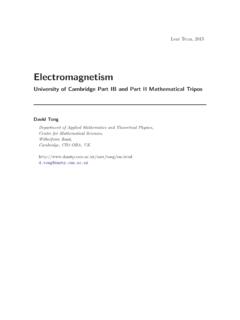Transcription of Chapter 2 Poisson’s Equation - damtp.cam.ac.uk
1 Chapter 2 poisson s Physical OriginsPoisson s Equation , 2 = (x),arises in many varied physical situations. Here (x) is the source term , and is often zero,either everywhere or everywhere bar some specific region (maybe only specific points).In this case, Laplace s Equation , 2 = 0, Diffusion EquationConsider some quantity (x) which diffuses. (This might be say the concentration ofsome (dilute) chemical solute, as a function of positionx, or the temperatureTin someheat conducting medium, which behaves in an entirely analogous way.) There is a cor-respondingflux,F, of that is, the amount crossing an (imaginary) unit area perunit time. Experimentally, it is known that, in the case of a solute, the flux is given byF= k wherekis thediffusivity; in the case of temperature, the fluxof heatis givenbyF= k Twherekis thecoefficient of heat conductivity. (Note that the minus signoccurs because the flux is directed towards regions of lower concentration.)
2 The governing Equation for this diffusion process is t=k 2 19 R. E. Hunt, 2002wherekis referred to, generically, as the diffusion constant. If we are interested inthesteady-statedistribution of solute or of temperature, then / t= 0 and Laplace sequation, 2 = 0, there aresourcesS(x) of solute (for example, where solute is piped in or wherethe solute is generated by a chemical reaction), or of heat ( , an exothermic reaction),the steady-state diffusion is governed by poisson s Equation in the form 2 = S(x) diffusion Equation for a solute can be derived as follows. Let (x) be the concentration of solute atthe pointx, andF(x) = k be the corresponding flux. (We assume here that there is no advectionof by the underlying medium.)LetVbe a fixed volume of space enclosed by an (imaginary) surfaceS. In a small time t, the quantityof solute leavingVis given by SF [ V dV]t+ tt= by tand taking the limit as t 0,ddt V dV= Sk.
3 NdS,and hence by the Divergence Theorem, V tdV= V .(k ) this is true foranyfixed volumeV, we must have t= .(k )everywhere. Assuming thatkis constant, we obtain thediffusion Equation t=k 2 .20 R. E. Hunt, 2002If there are alsosources(orsinks) of solute, then an additional source term results: t=k 2 +S(x)whereS(x) is the quantity of solute (per unit volume and time) being added to the solution at thelocationx. poisson s Equation for steady-state diffusion with sources, as given above, follows diffusion equationis derived similarly. LetT(x) be the temperature field in some substance(not necessarily a solid), andH(x) the corresponding heat field. We have the relationH= cTwhere is the density of the material andcits specific heat. The corresponding heat flux is k T. A similarargument to the above applies again, resulting in H t=k 2T+S(x)whereSrepresents possible sources of heat.
4 Hence T t= 2T+ ( c) 1S(x)where =k/ cis thecoefficient of thermal diffusivity. The Equation for steady-state heat diffusion withsources is as laws of electrostatics are . E= / 0 E=0 . B= 0 B= 0 Jwhere andJare the electric charge and current fields respectively. Since E=0,there is an electric potential such thatE= ; hence . E= / 0gives poisson sequation 2 = / a region where there are no charges or currents, andJvanish. Hence we obtainLaplace s Equation 2 = B=0so there exists a magnetostatic potential such thatB= 0 ; and 2 = a mass distribution with density (x). There is a corresponding gravitationalfieldF(x) which we may express in terms of a gravitational potential (x). Consider anarbitrary fixed volumeVwith surfaceScontaining a total massMV= V (x) R. E. Hunt, 2002 Gauss showed that the flux of the gravitational field throughSis equal to 4 SF.
5 NdS= 4 GMV= S . ndS= 4 G V (x) dV= V .( ) dV= 4 G V (x) is true for all volumesV, so we must have 2 = .( ) = 4 G .Other applicationsThese include the motion of an inviscid fluid; Schr odinger s Equation in quantum Me- chanics ; and the motion of biological organisms in a Separation of Variables for Laplace s EquationPlane Polar CoordinatesWe shall solve Laplace s Equation 2 = 0 in plane polar coordinates (r, ) where theequation becomes1r r(r r)+1r2 2 2= 0.(1)Consider solutions of the form (r, ) =R(r) ( ) where each functionR, is a functionof one variable only. Then1r r(r r)= ( )rddr(rdRdr)and1r2 2 2=R(r)r2d2 d after rearrangement,rRddr(rdRdr)= .(2)22 R. E. Hunt, 2002 The LHS is a function ofronly, and the RHS of only; hence both must be constant, say. Then = = = A+B = 0 Acos +Bsin 6= 0To obtain a sensible physical solution, replacing by + 2 should give the same valueof (see later).
6 This is true only if ( + 2 ) = ( ) ; , either = 0 orcos 2 = 1 and sin 2 = 0which implies 2 = 2n for some integern. (Note that the possibility that <0 isruled out at this stage.) Hence = A+B n= 0 Acosn +Bsinn n6= 0 Returning to (2),rRddr(rdRdr)= =n2= r2R +rR n2R= is easily shown (either by direct verification or by making the substitutionu= lnr)that the solutions of this Equation areR= C+Dlnr n= 0 Crn+Dr nn6= 0 Hence, we obtain possible solutions to (1) as =R = (C+Dlnr)(A+B )n= 0(Crn+Dr n)(Acosn +Bsinn )n6= 0We note that the combination lnrdoes not satisfy the requirement above for 2 -periodicity of , and so we exclude it. Equation (1) is linear and so we may forma superposition of the above solutions; in fact the general solution is an arbitrary linearcombination ofallthe possible solutions obtained above, that is =A0+B0 +C0lnr+ n=1(Anrn+Cnr n) cosn + n=1(Bnrn+Dnr n) sinn 23 R.
7 E. Hunt, 2002where we have relabelled all the arbitrary constants, ,AChas becomeAnandBDhas becomeDn. We can make this expression more compact by definingA n=CnandB n=Dnforn >0; then =A0+B0 +C0lnr+ n= n6=0rn(Ancosn +Bnsinn ).Although this is more compact, the first expression is often easier to :(i) Why did we require that , rather than itself, be periodic? In many cases( temperature, diffusion), must clearly be periodic and so we shall furtherneedB0= 0. But in other cases ( electrostatics, gravitation), is not itselfa physical quantity, only a potential; it is which has a physical significance( , the force). For example, consider the magnetostatic potential around a wirecarrying a currentI; here = (I/2 ) , which is multi-valued, butB= 0 (the quantity of physical interest) is of magnitude 0I/2 rand is single valued.(ii) A common mistake made during separation of variables is to retain too many arbi-trary constants; to write Cnrn(Ancosn +Bnsinn ).
8 For eachn, this looks like 3 arbitrary constants (An,Bn,Cn); but of course thereare really only two arbitrary quantities (CnAnandCnBn, which we have relabelledasAnandBnabove).(iii) The above derivation also applies to 3D cylindrical polar coordinates in the casewhen is independent Polar Coordinates: Axisymmetric CaseIn spherical polars (r, , ), in the case when we know tobe axisymmetric ( , independent of , so that / = 0),Laplace s Equation becomes1r2 r(r2 r)+1r2sin (sin )= solutions of the form (r, ) =R(r) ( ). Then1R(r2R ) = 1 sin ( sin ) (3)24 R. E. Hunt, 2002and both sides must be constant, say. So( sin ) = sin .Let = cos , and use the chain rule to replace d/d by d/d :dd =d d dd = sin dd .So sin dd ( sin2 d d )= sin = dd ((1 2)d d )+ = is Legendre s Equation ; for well-behaved solutions at = 1 ( , = 0, ) weneed =n(n+ 1) for some non-negative integern, in which case =CPn( ) =CPn(cos )whereCis an arbitrary to (3),(r2R ) = R= r2R + 2rR n(n+ 1)R= 0,to which the solution isR=Arn+Br n general solution to Laplace s Equation in the axisymmetric case is therefore (absorb-ing the constantCintoAandB) (r, ) = n=0(Anrn+Bnr n 1)Pn(cos ).
9 Non-axisymmetric Case [non-examinable]A similar analysis when may depend on shows that the general solution is (r, , ) = n=0n m= n(Amnrn+Bmnr n 1)Pmn(cos )eim wherePmn( ) are the associated Legendre functions which satisfy the associated Legendre equationdd ((1 2)d d )+(n(n+ 1) +m1 2) = 0whenmandnare integers,n 0, n m R. E. Hunt, Uniqueness Theorem for poisson s EquationConsider poisson s Equation 2 = (x)in a volumeVwith surfaceS, subject to so-calledDirichlet boundary conditions (x) =f(x) onS, wherefis a given function defined on the a physical point of view, we have a well-defined problem; say, find the steady-state temperature distribution throughoutV, with heat sources given by (x), subject toa specified temperature distribution on the boundary. No further conditions are requiredin real life to ensure that there is only one solution. Mathematically, then, can we showthat the problem above has a unique solution?
10 Suppose that there are actually two (or more) solutions 1(x) and 2(x). Let = 1 2. Then 2 = 2 1 2 2= = 0 inVsubject to =f f= 0 solution of this problem for is clearly = 0; is it unique? Consider .( ) = . + .( )=| |2+ 2 =| | V| |2dV= V .( ) dV= S . ndS= 0because = 0 onS. But| |2 0 everywhere; its integral can only be zero if| |is zero everywhere, , 0, which implies that is constant throughoutV. But = 0 onS, so 0 throughoutV. Thus 1= 2, which demonstrates that ourproblem has a unique solution, as similar theorem holds when instead of Dirichlet boundary conditions we haveNeu-mannboundary conditions: that is to say instead of being specified (by the function26 R. E. Hunt, 2002f) on the boundaryS, / nis specified onS, where we use the notation n n .. Minimum and Maximum Properties of Laplace sEquationSuppose that satisfies 2 = 0 in a volumeVwith surfaceS.
